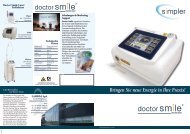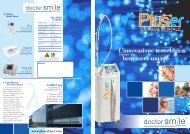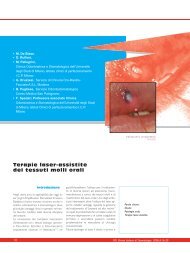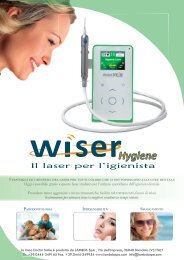SOFT TISSUE DIODE LASER - doctor smile
SOFT TISSUE DIODE LASER - doctor smile
SOFT TISSUE DIODE LASER - doctor smile
- No tags were found...
You also want an ePaper? Increase the reach of your titles
YUMPU automatically turns print PDFs into web optimized ePapers that Google loves.
Up to date literature atyour disposal to discoverthe benefits of laserdentistryFor further information contact info@<strong>doctor</strong>-<strong>smile</strong>.com +39-0444-349165
d e n t a l m a t e r i a l s & t e c h n o l o g ySoft Tissue Diode Laser:Where Have You BeenAll My Life?Fay Goldstep DDS, FACD, FADFE and Janet Press, RDHDental lasers have been commerciallyavailable for severaldecades. They have beenthoroughly documented in thedental literature. Lasers are anexciting technology, widely usedin medicine, kind to tissues, andexcellent for healing. So why havethey not been more widely embracedby the practicing dentist?There is a wide perception thatthe dental laser is not useful, toocomplicated, and too expensive.This has changed with the arrivalof the diode laser onto thedental scene. There is now a convergenceof documented scientificevidence, ease of use and greateraffordability that makes the diodelaser a “must have” for thedental practice.Diode Laser: Science in BriefL A S E R is an acronym forLight Amplification by StimulatedEmission of Radiation.Lasers are named for the substancewhich is stimulated. Inthe diode laser this substance isa semiconductor (a class of materialswhich are the foundation ofmodern electronics includingcomputers, telephones and radios).This innovative technologyhas produced a laser that iscompact and lower in cost. Mostof the research has focused onThere is now aconvergence of science,ease of use, andaffordability thatmakes the diodelaser a “must have”for the dental practicethe 810nm diode laser. Thiswavelength is ideally suited forsoft tissue procedures since it ishighly absorbed in haemoglobinand melanin. This gives the diodelaser the ability to preciselycut, coagulate, ablate or vaporizethe target tissue. 1Treatment with the 810nm diodelaser has been shown to havea significant long-term bactericidaleffect in periodontal pockets.A. actinomycetemcomitans,an invasive pathogen associatedwith the development of periodontaldisease and generallydifficult to eliminate, respondswell to laser treatment. 2,3 Scalingand root planing outcomes areenhanced with the addition of diodelaser therapy. The patient istypically more comfortable, andgingival healing is faster andmore stable. 4,5Diode Laser: Ease of UseEarly adopter dentists thrive onnew technology. They enjoy thechallenges that come with beingthe first to use a product. Mostdentists are not early adopters.Lasers have intimidated mainstreamdentists with their largefootprint, lack of portability, theirhigh maintenance profile of oper34 oralhealth July 2009
d e n t a l m a t e r i a l s & t e c h n o l o g yating tips and complex proceduralsettings. When do I use which tip?What setting works for which procedure?Why do I need a laserwhen I have been managing wellwithout one?Enter the diode laser. It is compact.It can easily be moved fromone treatment room to another. Itis self-contained and does nothave to be hooked up to water orair. It has one simple fiberopticcable which is easily transformedto an operating tip. The unitscome with several presets, althoughafter a very short time,the operator becomes so comfortablethat they are not even needed.The power and pulse settings aresimply adjusted to suit the particularpatient and procedure.On a personal note, I am a dentistwho does not thrive on thechallenge of brand new high-tech,high-stress technology. I havetried many lasers in the past thatpromised to be user-friendly; theywere anything but. With the810nm diode laser, after a shortin-office demonstration, I wasable to pick up the handpiece andto feel comfortable enough to performsome simple procedures. IThe diode laser iscompact, easily moved,self-contained anddoes need water orair hook-upshave since taken online training,as well as lecture courses, whichhave enhanced both my comfortlevel and my competency.Diode laser: AffordabilityLaser technology has alwayscome with a high price tag.Manu fac turing costs are highand cutting edge technologycommands steep pricing. Diodelasers are less expensive to produce.Breakthrough pricing forthis technology has now reachedwell under CAN$10,000. At thislevel the diode laser becomes affordablefor the average practicingdentist.Diode laser: Why do I needthis technology?The 810nm diode laser is specificallya soft tissue laser. Thiswavelength is ideally suited forsoft tissue procedures since it ishighly absorbed in haemoglobinand melanin, both of which areprevalent in soft tissues. Thisgives the diode laser the ability toprecisely cut, coagulate, ablate orvaporize the target tissue withless trauma, improved post-operativehealing, and faster recoverytimes. 6,7,8 Given the incredibleFigure 1—Soft tissue covering gingivalmargin of fractured tooth. (Photo courtesyDr. Phil Hudson)Figure 2—Laser outline of gingivectomy.(Photo courtesy Dr. Phil Hudson)Figure 3—Laser gingivectomy completed.(Photo courtesy Dr. Phil Hudson)Figure 4—Hard tissues etched for immediaterestoration. (Photo courtesy Dr.Phil Hudson)Figure 5—One week post-op. (Photocourtesy Dr. Phil Hudson)Figure 6—Laser positioning for gingivaltroughing. (Photo courtesy Dr. RobertLowe)July 2009 oralhealth 35
d e n t a l m a t e r i a l s & t e c h n o l o g yFigure 7—Close-up of laser positioning insulcus. (Photo courtesy Dr. Robert Lowe)Figure 8—Infected operculum distal tosecond molar. (Photo courtesy IvoclarVivadent)Figure 9—Laser removing operculum.(Photo courtesy Ivoclar Vivadent)Figure 10—Operculectomy completed.(Photo courtesy Ivoclar Vivadent)Figure 11—Gingival condition prior toLaser Assisted Periodontal Treatment.(Photo courtesy Dr. William Chen)Figure 12—Gingival condition afterLaser Assisted Periodontal Treatment.(Photo courtesy Dr. William Chen)ease of use and its versatility intreating soft tissue, the diode laserbecomes the “soft tissue handpiece”in the dentist’s armamentarium.The dentist can use thediode laser soft tissue handpieceto remove, refine and adjust softtissues in the same way that thetraditional dental handpiece isused on enamel and dentin. Thisextends the scope of practice ofthe general dentist to includemany soft tissue procedures.The following procedures arean easy entry point for the newlaser user:1. GingivectomyHaemostasisGingival Troughing forim pres sions.The diode laser’sversatility in treatingsoft tissue makes itthe “soft tissue handpiece”in the dentist’sarmamentariumThe diode laser makes restorativedentistry a breeze. Any gingivaltissue that is covering atooth during preparation can beeasily removed and haemostasisachieved simultaneously. The restorationis no longer compromisedbecause of poor gingival conditions.There is no more battlingwith unruly soft tissue and blood(Figs. 1-5).Gingival troughing prior toimpression taking helps to ensurean accurate impression andan improved restorative outcome.Packing cord is no longernecessary (Figs. 6 & 7).With these procedures, restorativedentistry becomes lessstressful, more predictable andmore enjoyable for the dentalteam and the patient.2. OperculectomyGingival Hyperplasia:Excision and/or recontouringof gingival hyperplasia.These procedures are usuallynot offered or performed by thegeneral dentist. They are examplesof the expanded range of servicesreadily added to the generalpractice. The dentist becomesmore proactive in dealing withhyperplastic tissues that can increaserisk of caries and periodon36 oralhealth July 2009
d e n t a l m a t e r i a l s & t e c h n o l o g ytal disease (Figs. 8-10).3. Laser AssistedPeriodontal TreatmentThe use of the diode laser in conjunctionwith scaling and rootplaning is more effective thanscaling and root planning alone. Itenhances the speed and extent ofthe patient’s gingival healing andpost-operative comfort. 4,5 This isaccomplished through laser bacterialreduction, debridement andbiostimulation (Figs. 11 & 12).A. actinomycetemcomitanswhich has been implicated in aggressiveperiodontitis may also beimplicated in systemic disease. Ithas been found in atheroscleroticplaque 9 and there has been recentdata suggesting that it maybe related to coronary heart disease.10 The diode laser is effectivein decreasing A. actinomycetemcomitans,2,4 and thereby indirectlyimproving the patient’sheart health.Laser EducationMost diode laser manufacturersprovide some education to get thenew user started. The most comprehensiveonline, unbiased, unaffiliateddiode laser introductorycourse with certification (whichincludes the science, safety andclinical procedures) can be foundat www.advancedlasertraining.com. This course provides everythingnecessary to get you startedwith soft tissue diode lasers.Advanced courses are availableTable 1.Manufacturer Product Distributor Telephone WebsiteAMD Picasso Oral Science 1-888-442-7070 www.oralscience.comBiolase EZ Lase Schein 1-800-488-6113 www.hsa.caIvoclar VivadentZAP AdvancedLaser SystemsOdysseyZAPPatterson,Schein, SinclairNo Canadiandistribution1-800-263-8182 www.ivoclarvivadent.ca1-888-876-4546 www.zaplasers.comfor more complex procedures.The soft tissue diode laser israpidly becoming a “must have”mainstream technology for thegeneral practice. The science, easeof use, and affordability make itsimple to incorporate. It becomesthe essential “soft tissue handpiece”for the practice. The timemay soon come when a diode laserSoon, the diodelaser will have aplace in everyrestorative andhygiene treatmentroomwill be placed in each restorativeand each hygiene treatment room.Restorative dentistry becomeseasy, predictable and less stressful.The scope of practice is expandedto include new soft tissueprocedures that keep patients inthe office. The patient’s gingivalhealth is improved in a minimallyinvasive, gentler manner. Everytime the dentist picks up the diodelaser the question is: wherehave you been all my life? ohDr. Fay Goldstep sitson the Oral Health Editorial Board (Healing/Preventive Den tistry),has served on the teachingfaculties of the Post-graduatePrograms in Esthetic Dentistry atSUNY Buffalo, the Universities ofFlorida (Gaines ville), Minnesota(Minne apolis), and is an ADASeminar Series featured speaker.She lectures nationally and internationallyon Healing Dentistry,Innovations in Hygiene, DentistHealth Issues and Office Design,and has published on these topics.Dr. Gold step is a consultant to anumber of dental companies, andmaintains a private practice inMarkham, ON, Canada and canbe reached at goldstep@epdot.com.Janet Press, RDH,Fellow of the Academyof Laser Dentistry, aHygienist for 34 yearswith 14 years clinicalexperience in laser.Janet lectures internationally onsoft tissue laser.Oral Health welcomes this originalarticle.References1. Pirnat S, Versatility of an 810 nm Diode Laser inDentistry: An Overview, Journal of Laser and HealthAcademy Vol. 2007 No. 4 1 -82. Moritz A, Schoop U, Goharkhay K, Schauer P,Doertbudak O, Wernisch J, Sperr W, Treatment ofperiodontal pockets with a diode laser, Lasers SurgMed, 1998; 22(5): 302-113. Moritz A, Schoop U, Goharkhay K, Schauer P,Doertbudak O, Wernisch J, Sperr W, bacterialreduction in periodontal pockets through irradiationwith a diode laser: a pilot study, J Clin Laser MedSurg. 1997 Feb; 15(1): 33-74. Ciancio SG, Kazimerczak M, Zambon JJ,Baumbartner S, Bessinger MA, Ho A, clinical Effectsof diode laser treatment of wound healing, AADR,2006, abs 21835. Haraszthy VI, Zambon MM, Ciancio SG, ZambonJJ, Microbiological Effects of 810 nm Diode LaserTreatment of Periodontal Pockets, AADR 2006,abs 11636. Goharkhay K, Mortiz A, Wilder-Smith P, Schoop U,Kluger W, Jakolitsch S, Sperr W, Effects on oral softtissue produced by a diode laser in vitro, LasersSurg Med, 1999; 25(5): 401-67. Walinski CJ, Irritation Fibroma Removal: AComparison of Two Laser Wavelengths, Gen Dent2004, May - June; 52(3): 236-88. Adams TC, Pang PK, Lasers in Aesthetic Dentistry,Dent Clin North Am, 2004 Oct; 48(4): 833-60, vi9. Haraszthy VI, Zambon JJ, Trevisan M, etal, Identification of Periodontal Pathogensin Atheromatous Plaques, J Periodontol 2000,71:1554-156010. Spahr A, Klein E, Khuseyinova N, et al, PeriodontalInfections and Coronary Heart Disease: Role ofperiodontal bacteria and importance of total pathogenburden in the Coronary Event and PeriodontalDisease (CORODONT) study, Arch Intern Med,2006 166:554-55938 oralhealth July 2009










